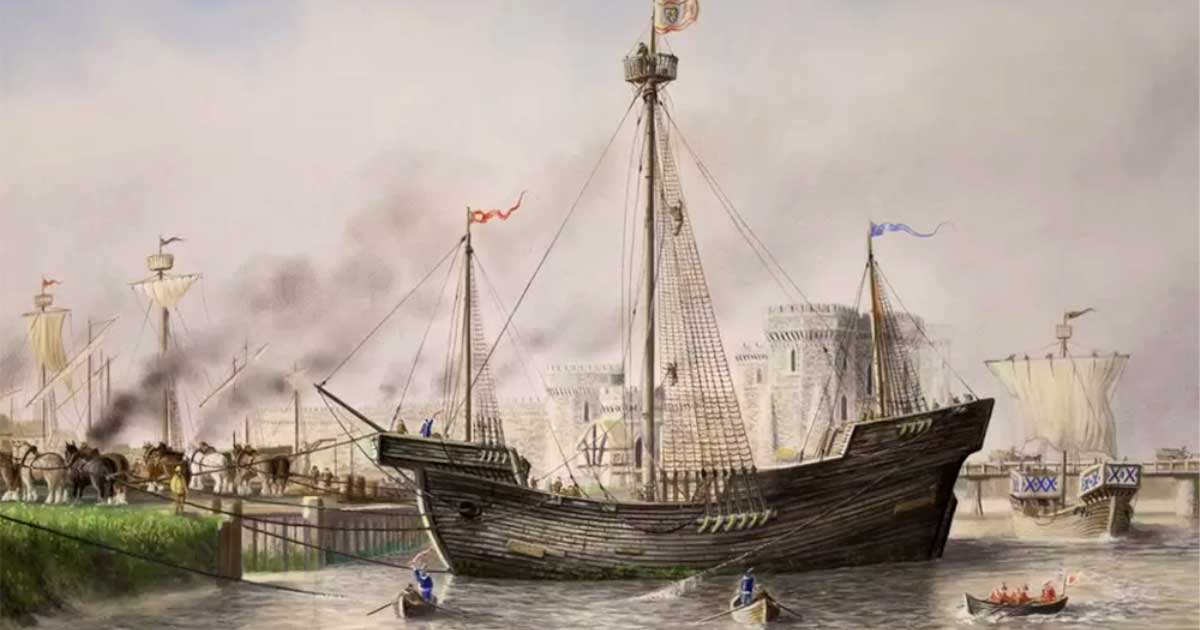Rebuilding the Newport Ship: The Welsh Shipwreck Rivalling the Mary Rose
In 2022, the Newport Ship was discovered in the River Usk near Newport in Wales. Considered one of the most significant archaeological finds in the United Kingdom, after years of restoring the plethora of parts, a team of archaeologists now has to put together what may be the world’s most complicated puzzle, 550 years after it sunk. Radiocarbon dating has determined that the ship was built between 1460 and 1483 AD.
- Medieval Wine ‘Supertanker’ Saved by Community in Wales
- Researchers Believe They May Have Located a Famous Ship Once Owned by Captain Cook
Built in oak and measuring approximately 30 meters (98 ft) long, and weighing in at around 400 tonnes, the ship sailed for about a decade before it was deliberately sunk. Now, with almost 2,500 separate pieces having been dried out and restored, the ancient vessel is now ready to be reassembled.
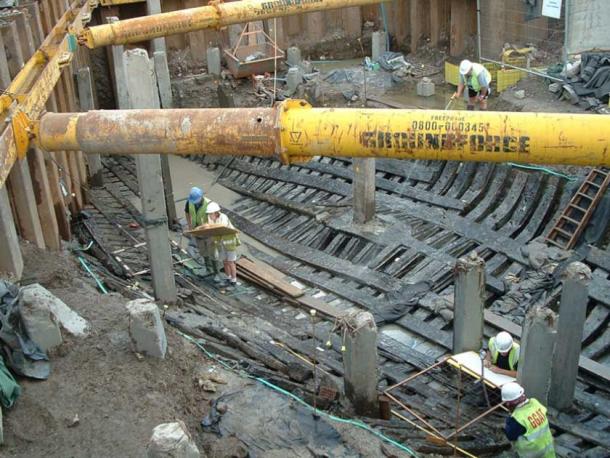
Excavations of the Newport Ship in 2002 during the building of the Riverfront Arts Center in Newport, Wales. (Owain / CC BY-SA 3.0)
The Global Significance of the Newport Ship
Archaeologists think this medium-sized boat had a refit in a River Usk inlet in either 1468 or 1469 AD after having sailed from the Iberian Peninsula to Bristol. Evidence suggests the ship’s moorings broke and that the oak planks and iron were stripped before a third of the vessel was eventually swallowed by silt.
According to a report in the BBC, archaeologists describe this rare 15th century ship as “the world’s largest 3D puzzle.” Compared in significance to the 1982 discovery of King Henry VIII's flagship, the Mary Rose, what makes this ship even more valuable is that it was constructed a century earlier. And this is one of the reasons why TV historian Dan Snow said the ship is “of global significance and interest.”
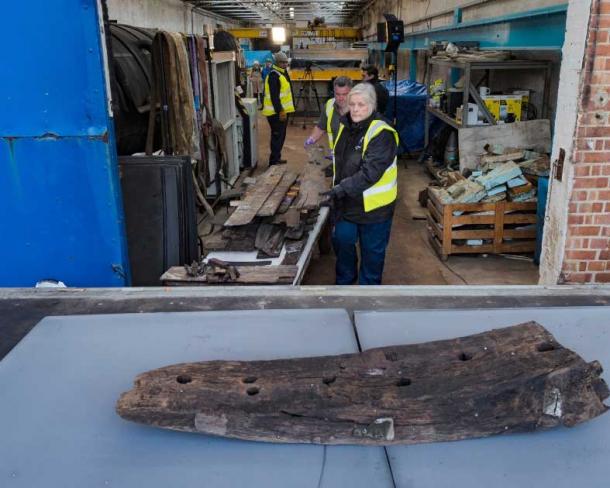
Some of the many excavated parts of the Newport Ship. (Newport Medieval Ship Project)
This Isn’t An Ikea Cupboard!
The project's curator, Toby Jones, explained that the teams of archaeologists have “a massive, flat-pack ship” that needs to be reassembled. The archaeologist said a lot of fitting, checking and disassembling and fitting again and again, is now required. Jones added that unlike an Ikea cupboard, this complex build comes with “no instructions.”
Fans of ancient European navigators and their ships really are spoilt for choice. To name a few, the Viking Ship Museum in Roskilde, Denmark, features five well-preserved Viking ships from the 11th century. The Vasa Museum in Stockholm, Sweden, displays the 17th-century warship Vasa, which sank on its maiden voyage in 1628. Meanwhile, the Mary Rose Museum in Portsmouth, England, exhibits the 16th-century warship known as the Mary Rose, which sank in the Solent in 1545 AD.
While ships from the 11th, 17th and 18th centuries have been found, preserved and put on display, this is the first time that a 15th century vessel has been discovered and restored. It really is one of a kind, or in the words of project manager Toby Jones, “it’s totally unique.” And so stand alone is this discovery that even the head of conservation at the Mary Rose Museum, David Pearon, said the Newport Ship is up on the “same scale,” as the Rose.
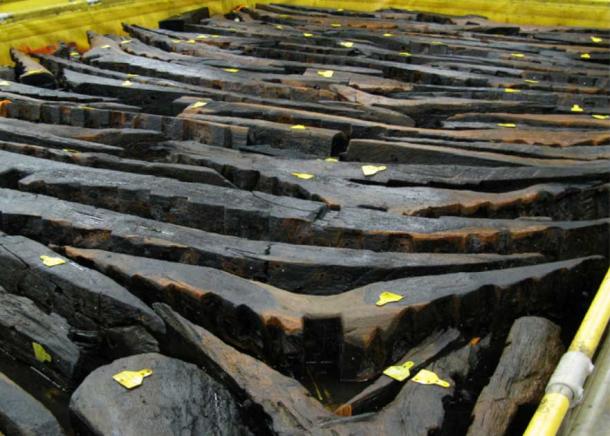
Now the task of reassembling the parts of the Newport Ship begins. (Friends of the Newport Ship)
Resurrecting a Ghostly Vessel – The Rare Newport Ship
The Mary Rose was built in Portsmouth, England, and launched in 1511 AD as the ‘warship’ of King Henry VIII of England and it was primarily used in military campaigns against the French and Scottish navies. The Mary Rose was equipped with a variety of heavy guns and had a crew of around 400 men.
On the other hand, the Newport Ship is a 15th century trading ship and no others of this class have ever been discovered. The primary reason for this is that they were typically made of wood and were often used for many years, until they were no longer seaworthy. But now the New Port vessel is being restored, a high-resolution archaeological story of life, and death, onboard the rare ship will soon emerge.
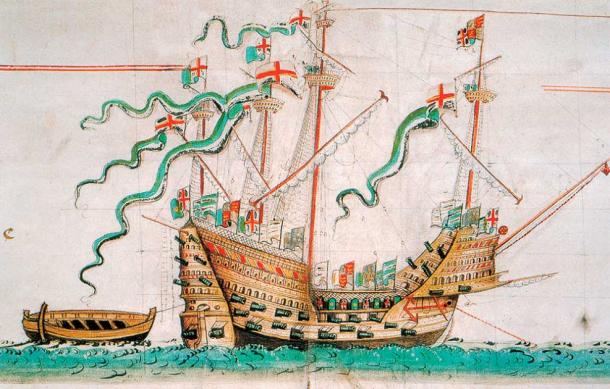
Illustration of the Mary Rose warship which belonged to King Henry VIII of England whose remains were discovered in 1982 after sinking during battle in 1545 AD. (Public domain)
Archaeologists Face a Five Year Slog Ahead
Presenter and historian Dan Snow said the Newport Ship symbolizes “the birth of a new era of European exploration and ship building.” He explained that in the 15th century, people from Brittany, northern Spain, Portugal, Devon and Cornwall began building stronger and larger ships.
With these new advances in ship design came a bolder class of navigator who would forge new routes into uncharted oceanic zones, eventually leading to the crossing of the Atlantic and penetration of the Indian Ocean. The history of Newport Ship is part of this complex story of ancient shipping.
- 8 Lost Shipwrecks That Still Hold Promise of Treasure and Fame
- Authorities Give Protection to a Rare 16th Century Tudor Shipwreck Found on an English Beach
The reason for the Newport Ship appearing in the news this week in particular, is because the team made their final visit to England's south coast on Thursday and collected the last 100 or so timbers of the Newport Ship to bring back to Newport. The end game, now that all the timeworn jigsaw pieces are on the table, is to reassemble the wreckage over the next five years and to present the world with a rival to the legendary Mary Rose.
Top image: How the Newport Ship may have looked as it docked at Newport in the 15th Century. Source: Newport Museums and Heritage Service
By Ashley Cowie
















